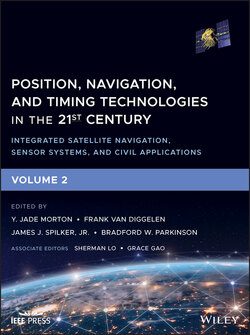Читать книгу Position, Navigation, and Timing Technologies in the 21st Century - Группа авторов - Страница 119
38.9 Cellular‐Aided INS
ОглавлениеTraditional integrated navigation systems, particularly onboard vehicles, integrate GNSS receivers with an INS. When these systems are integrated, the long‐term stability of a GNSS navigation solution complements the short‐term accuracy of an INS. GNSS–INS fusion architectures with loosely coupled, tightly coupled, and deeply coupled estimators are well studied [87]. Regardless of the coupling type, the errors of a GNSS‐aided INS will diverge in the absence of GNSS signals, and the rate of divergence depends on the quality of the IMU. Cellular signals could be used in place of GNSS signals to aid an INS [44]. This section outlines how cellular signals could be used to aid an INS in the absence of GNSS signals. Additional details can be found in [4, 45, 88, 89].
This section is organized as follows. Section 38.9.1 discusses how to aid the INS with cellular signals in a radio SLAM fashion. Sections 38.9.2 and 38.9.3 present simulation and experimental results, respectively, of a UAV navigating in a radio SLAM fashion, while aiding its INS with ambient cellular signals.
Figure 38.63 Experimental results comparing the navigation solution uncertainty ellipsoids produced by (1) GPS alone and (2) GPS and cellular CDMA and LTE. Map data: Google Earth (Kassas et al. [6]).
Source: Reproduced with permission of IEEE.
